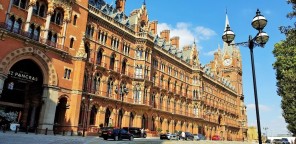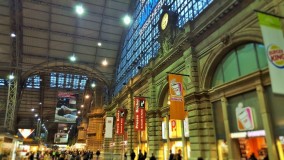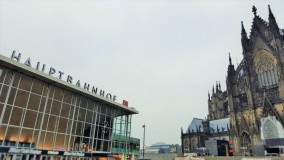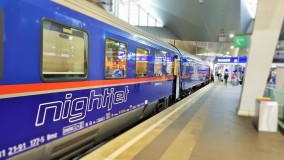Related Content
Content

Wien / Vienna to London by train
How take a rail journey from Vienna/Wien to London
There are three options available when taking a journey by train from Wien/Vienna to London:
-
Despite the current reduction in the number of Eurostar departures it is still a straightforward journey by day with only two changes of train required.
-
What is currently compromised is what is usually the simplest option for a rail journey between the Austrian and UK capital cities, which involves just two trains; the night train to Bruxelles and the Eurostar on to London.
The night train departs Wien Hbf on Tuesday, Thursday and Sunday evening, but its usual connecting service on from Bruxelles-Midi station is among those services which remain suspended.
Therefore for the moment, spending most of the day in Bruxelles is required, if you want to leave Wien/Vienna by this train. -
Also compromised is the overnight option on the evenings when the Wien to Bruxelles train isn't available.
The required additional connection from Koln to Bruxelles also arrives at Midi station at around 09:30 and the next Eurostar on to London isn't departing until 16:00.
Share
Routes
Option 1: travelling by day
Journey Summary
from 13hr 7min
Daily
Travel Information
The booking agents will offer multiple combinations of trains for journey by day from Vienna/Wien to London, but the easiest routing is to make only two changes of train; and to make those connections in Frankfurt (Main) Hbf and Bruxelles-Midi/Zuid stations.
Frankfurt (Main) hbf is an exceptionally straightforward location in which to have to connect between trains and the connection in Bruxelles/Brussels avoids having to transfer between stations in Paris; and many of the other journey options will involve travelling via the French capital.
The typically available schedules are;
Daily:
- Depart Wien Hbf at 06:50
- Depart Frankfurt (Main) hbf at 14:27 (51 min connection)
- Depart Bruxelles-Midi at 18:26 on Mon to Fri, 47 min connection; on Sat/Sun at 17:56 (21 min connection)
- Arrive London St Pancras at 19:27 on Mon to Fri; at 18:57 on Sat/Sun
Not Saturday:
- Depart Wien Hbf at 09:15
- Depart Frankfurt (Main) hbf at 16:29 (53 min connection)
- Depart Bruxelles-Midi at 20:56 (81 min connection)
- Arrive London St Pancras at 21:57
As can be seen the only particularly tightly timed connections are the weekend connections in Bruxelles when departing Wien at 06:50, it's not uncommon for the ICE trains from Frankfurt (Main) to arrive in Bruxelles more than 10 mins late; and on Saturdays you will be connecting into the final train of the day.
The option for departing at 09:15 on the other days of the week has theoretically easy transfers between trains available, but the Eurostar will be the final departure of the the day on from Bruxelles.
Depart Wien at -06:50 on any day, but Saturday and more contingency time will be available should trains not operate to schedule, as that later 20:56 Eurostar will typically be available.
Mon-Fri = 2 x connections per day
Saturday = 1 x connection
Sunday = 2 x connections
Change trains in: Frankfurt (Main) and Bruxelles/Brussels
Tickets
Book early and save: Yes
Online bookings open: 6 months ahead of the travel date
The ticket agents don't tend to sell end-to-end journeys for the options which depart Wien/Vienna at 06:50, possibly because the completing the route, when setting off at this time is reliant on making two non-guaranteed transfers in under an hour.
So an option is to split the booking into separate tickets for the Wien to Frankfurt and Frankfurt to London sections of the journey.
Though by doing do, you will have to re-book the Frankfurt to London journey in the event of missing a connection, so an option to protect against this scenario is to spend more than two hours in Frankfurt and book the later train on to Bruxelles.
If you do manage to make an end-to-end booking which departs Vienna at 06:50; in the unlikely event of missing the scheduled connection at Frankfurt (Main) due to a late arriving train, speak to the train manager on the Wien to Frankfurt ICE.
Tickets can be transferred free of charge to alternative departures - though you will have to make an additional change of train in Koln/Cologne.
Seat reservations
The price will include the costs of the optional reservations on the ICE trains.
If you don't want to pay this additional charge, you can de-select the reservation when making a booking, but the reservations are highly recommended on such a long journeys as this; particularly on the journey between Wien/Vienna and Frankfurt (Main).
The reserved seat(s) will automatically be assigned when making a booking on the Eurostar.
Where to book
| Ticket Provider | Approximate Cost | |
|---|---|---|
| RailEurope | ||
| Trainline | * |
Train 1
Travelling On
Journey Features
Good to Know
Departing from Wien/Vienna:
Most of these ICE trains between Wien/Vienna and Frankfurt (Main) commence their journeys at Wien Flufghagen/Vienna Airport station
If your journey in Vienna is commencing in the south west corner of the city, or the area on the ring road around the Opera House - then it's likely that you'll have a faster and more convenient journey if you join the train at Wien-Meidling station.
Wien Meidling is connected to line U6 of the Vienna Metro, which serves the western side of the city centre.
Though we particularly recommend opting to make reservations on these trains if you want to join these trains at Wien-Meidling.
All trains also call at: Linz, Wels, Passau, Regensburg, Nurnberg, Wurzburg




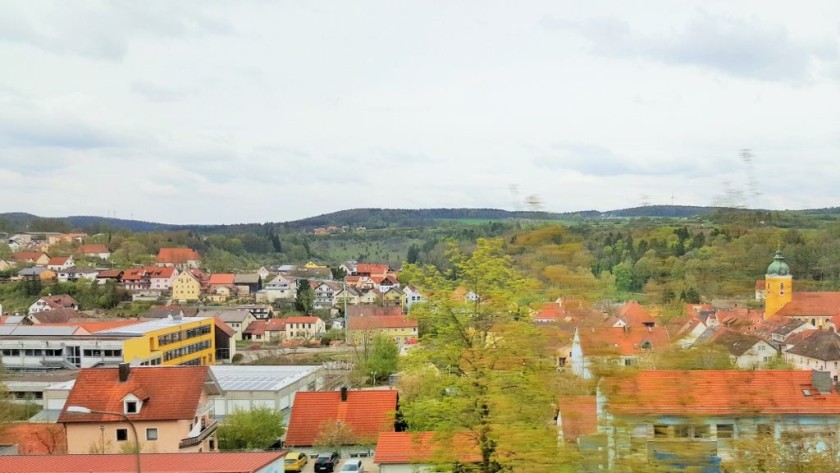
From Wien/Vienna until Wels the train will travel at up to 230 km/h (close to the high speed threshold) on the main Western Railway which crosses Austria.
On departure from Wells the train will head towards the border with Germany and to the south of Passau, the railway takes a charming route on the east bank of The River Inn, which can be seen on left.
Then between Passau and Regensburg the River Danube is on the right.
Between Regensburg and Nurnberg the train rushes across a delightful rolling landscape and then until Wurzburg the train remains on the conventional railway.
On departure from Wurzburg comes a part of the journey with a wow factor, the train will be on the high speed line for less than 15 minutes, but there are some nice views as the train crosses some long viaducts; in particular look out for when the train will burst out of a tunnel and then immediately cross the River Main.
Between this river bridge and Aschaffenburg comes another scenic part of the trip when the railway winds through some valleys.
As the train will spend less than 3% of its journey on the high speed line, it didn't see right to put this journey in the high speed (partial) category.


Train 2
Travelling On
Journey Features
Good to Know
Final Destination: Bruxelles-Midi/Brussel Zuid


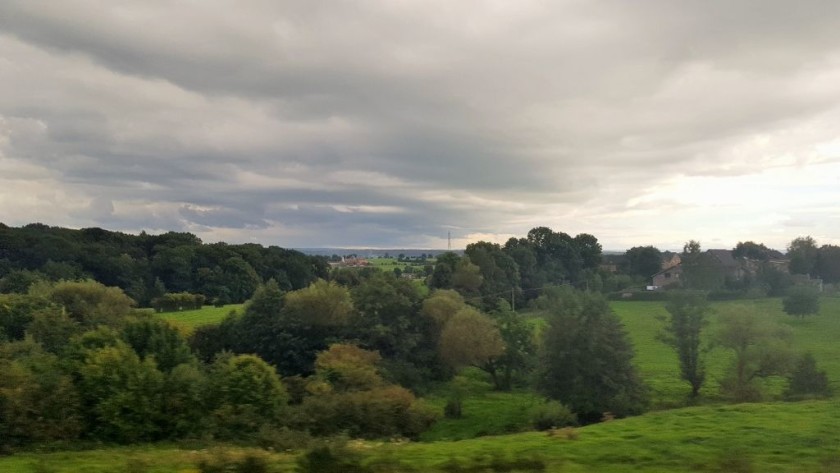

A fabulous journey by high speed train
Connect at Bruxelles-Nord for Bruxelles-Central station
This route showcases high speed train travel at it's finest, the journey between Frankfurt Flughafen and Seigburg/Bonn in particular can fuel adrenalin!
For virtually the entire train journey from Koln to Bruxelles the trains, will either be travelling at up to 290 km/h on purpose built high speed lines, or up to 200km/h on section of railway, that has been re-engineered to allow trains to travel faster.
It is a journey of eight distinct phases:
- Until Frankfurt Flughafen the train will snake its ways through the city's suburbs
- The train will then spend around 40 minutes travelling at more than 270 km/h on the high speed line.
The video was taking on a train travelling in the opposite direction, but it gives a sense of what a thrill this train ride can be; this is a journey when it's especially obvious that you're travelling on a high speed train!
- Between Koln and Aachen the trains travel at up to 200 km/h on a re-engineered stretch of railway.
- Then for most of the the 25 min journey between Aachen and Liege the train will travel at up to 290 km/h on a high speed line; this is also the most scenic part of the trip.
- Then for around five minutes after departure from Liege, the train will travel fairly slowly on a route which ascends from the city.
- Next up is the HS2 Belgian high speed route as far as Leuven, in theory the ICE and Thalys trains can accelerate back up to around 290 km/h on this part of the trip.
- From Leuven to just north of Brussel-Nord station the maximum speed is 200 km/h.
- For most of the journey between Brussel-Nord and Brussel-Zuid the railway crosses the city centre in a tunnel.
Train 3
Travelling On
Journey Features
Good to Know
As a consequence of the Covid-19 crisis Eurostar is operating a particularly limited timetable for the time being - further information is available on Eurostar.com
Final Destination: London St. Pancras International
Some trains* also call at : Ebbsfleet International; Ashford International (these station calls are suspended for the time being)
Note that London is in a different time zone to mainland Europe, it is one hour behind - so when looking at a timetable the journey will look as though it's an hour shorter.
Most of the departures between Bruxelles/Brussels and London will be by the e320 trains; but the e300 trains are also used on this route.
Our guide to taking the Eurostar from Bruxelles/Brussels has more information including details of check-in and how to connect into the Eurostar from other train services.
Our guide to arriving by Eurostar in London is here.


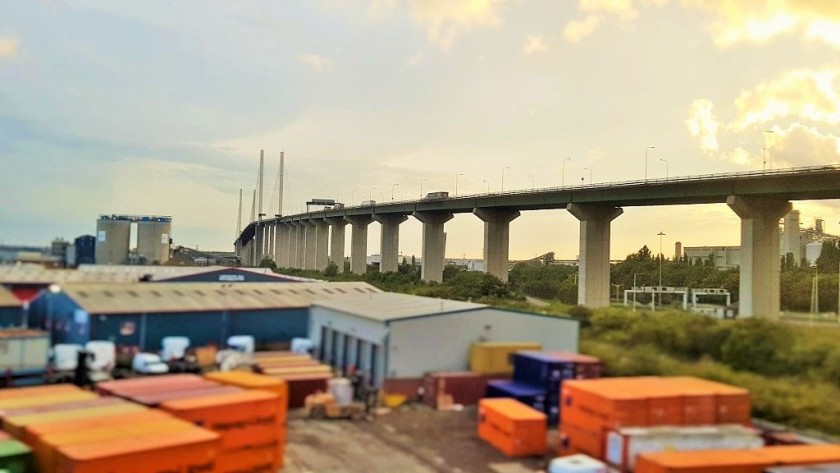
It's not a scenic journey, but it is a journey with distinct phases and highlights:
1: There is little to see from the high speed lines in Belgium and France.
2: The train will slow down as it approaches The Channel Tunnel.
Announcements are no longer made that the train is about to enter the tunnel.
The journey through the tunnel will take around 22 mins.
3: As the train nears Ebbsfleet International station, comes the scenic highlight of the journey - the crossing of the River Medway on a high bridge.
4: After Ebbsfleet International (which can only be seen from the right) the train will enter a tunnel under the River Thames.
As the train exits this tunnel, from the left, the Queen Elizabeth II road bridge can be seen.
5: For most of the final 8 -10 mins of the journey the trains use tunnels to enter London (Stratford International station is located between the tunnels).


Option 2: travelling overnight when departing on Tues/Thurs/Sun
Journey Summary
----
Not Every Day
Travel Information
On Tuesday, Thursday and Sunday evenings a Nightjet train to Bruxelles will usually be scheduled to depart from Wien Hbf at 20:13, the train is timed to arrive in Bruxelles/Brussels at 09:55.
However, the early afternoon Eurostar on to London has been temporarily suspended, hence the 'connecting' train depart Bruxelles at 15:52
So you will need to make separate bookings for each part of the journey.
Though with the available time you could do something fabulous such as hopping on train for a quick exploration of the likes of Antwerp or Gent.
Train 1
Travelling On
Journey Features
Good to Know
Final Destination: Bruxelles-Midi/Brussel-Zuid
The train also calls at: Linz
The journey experience is dependent on the type of accommodation you choose to travel by on the train - click the 'Nightjet' train details to discover the available options.
Train 2
Travelling On
Journey Features
Good to Know
As a consequence of the Covid-19 crisis Eurostar is operating a particularly limited timetable for the time being - further information is available on Eurostar.com
Final Destination: London St. Pancras International
Some trains* also call at : Ebbsfleet International; Ashford International (these station calls are suspended for the time being)
Note that London is in a different time zone to mainland Europe, it is one hour behind - so when looking at a timetable the journey will look as though it's an hour shorter.
Most of the departures between Bruxelles/Brussels and London will be by the e320 trains; but the e300 trains are also used on this route.
Our guide to taking the Eurostar from Bruxelles/Brussels has more information including details of check-in and how to connect into the Eurostar from other train services.
Our guide to arriving by Eurostar in London is here.



It's not a scenic journey, but it is a journey with distinct phases and highlights:
1: There is little to see from the high speed lines in Belgium and France.
2: The train will slow down as it approaches The Channel Tunnel.
Announcements are no longer made that the train is about to enter the tunnel.
The journey through the tunnel will take around 22 mins.
3: As the train nears Ebbsfleet International station, comes the scenic highlight of the journey - the crossing of the River Medway on a high bridge.
4: After Ebbsfleet International (which can only be seen from the right) the train will enter a tunnel under the River Thames.
As the train exits this tunnel, from the left, the Queen Elizabeth II road bridge can be seen.
5: For most of the final 8 -10 mins of the journey the trains use tunnels to enter London (Stratford International station is located between the tunnels).


Option: travel overnight, when departing on any evening
Journey Summary
18hrs 50mins
Nightly
Travel Information
The OBB Nightjet train, that usually departs from Wien at 20:13, is due to arrive in Koln hbf station at 06:51
At 07:42 an ICE train departs from Koln Hbf for Bruxelles/Midi and is due to arrive there at 09:35, but due to the current reductions on the Eurostar timetable, the next train on to London won't be departing until 16:00
So the only option is to book separate tickets for the Wien to Bruxelles and Bruxelles to London journeys.
Change trains in: Koln/Cologne and Bruxelles/Brussels
Train 1
Travelling On
Journey Features
Good to Know
On departure from Wien Hbf it will be joined to another train heading to Hamburg, so if you see 'Hamburg' on the departure screens, then the info will also be for this train.
Don't be concerned about joining the wrong part of the train, your reservations will be in the part of the train that will be heading to Koln.
And the train conductor will greet passengers travelling in the sleeping cabins.
This train also departs from: Wien Meidling, St Polten and Linz.
This train terminates at: Amsterdam
On summer mornings when the sun rises before 06:00, if you happen to wake early, you'll get the chance to see some fabulous views of The Rhine Gorge north of Mainz
).


Train 2
Travelling On
Journey Features
Good to Know
Final Destination: BruxellesMidi/Brussel Zuid



For virtually the entire train journey from Koln to Bruxelles the trains, will either be travelling at up to 290 km/h on purpose built high speed lines, or up to 200km/h on section of railway, that has been re-engineered to allow trains to travel faster.
It is a journey of six distinct phases:
- Between Koln and Aachen the trains travel at up to 200 km/h on a re-engineered stretch of railway.
- Then for most of the the 25 min journey between Aachen and Liege the train will travel at up to 290 km/h on a high speed line; this is also the most scenic part of the trip.
- Then for around five minutes after departure from Liege, the train will travel fairly slowly on a route which ascends from the city.
- Next up is the HS2 Belgian high speed route as far as Leuven, in theory the ICE and Thalys trains can accelerate back up to around 290 km/h on this part of the trip.
- From Leuven to just north of Brussel-Nord station the maximum speed is 200 km/h.
- For most of the journey between Brussel-Nord and Brussel-Zuid the railway crosses the city centre in a tunnel.
Train 3
Travelling On
Journey Features
Good to Know
As a consequence of the Covid-19 crisis Eurostar is operating a particularly limited timetable for the time being - further information is available on Eurostar.com
Final Destination: London St. Pancras International
Some trains* also call at : Ebbsfleet International; Ashford International (these station calls are suspended for the time being)
Note that London is in a different time zone to mainland Europe, it is one hour behind - so when looking at a timetable the journey will look as though it's an hour shorter.
Most of the departures between Bruxelles/Brussels and London will be by the e320 trains; but the e300 trains are also used on this route.
Our guide to taking the Eurostar from Bruxelles/Brussels has more information including details of check-in and how to connect into the Eurostar from other train services.
Our guide to arriving by Eurostar in London is here.



It's not a scenic journey, but it is a journey with distinct phases and highlights:
1: There is little to see from the high speed lines in Belgium and France.
2: The train will slow down as it approaches The Channel Tunnel.
Announcements are no longer made that the train is about to enter the tunnel.
The journey through the tunnel will take around 22 mins.
3: As the train nears Ebbsfleet International station, comes the scenic highlight of the journey - the crossing of the River Medway on a high bridge.
4: After Ebbsfleet International (which can only be seen from the right) the train will enter a tunnel under the River Thames.
As the train exits this tunnel, from the left, the Queen Elizabeth II road bridge can be seen.
5: For most of the final 8 -10 mins of the journey the trains use tunnels to enter London (Stratford International station is located between the tunnels).


Newsletter
Sign up to receive the latest travel news stories and to hear about what we've been working on for you.
See if there’s a unique journey guide for your trip, featuring info on the trains, tickets & stations.

This is one of more than 1000 journey guides available on ShowMeTheJourney, which will make it easier to take the train journeys you want or need to make. As always, all images were captured on trips taken by ShowMeTheJourney.

